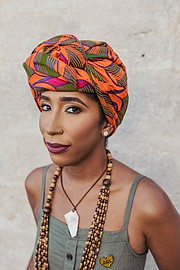GABRIELLE “Gabby” Petito, a 22-year-old white woman went missing while on a cross-country road trip to Wyoming with her fiancé Brian. They had been documenting their trip on YouTube as Nomadic Statik and Van Life, but 23-year-old Brian returned to Florida, in her 2012 Ford Transit van, without her on September 1.
Her parents, who had not heard from her, reported her missing ten days later. Brian refused to speak with the police, and her parents pleaded with the public and with him to come forward with any information regarding Gabby’s disappearance.
Attorney Richard Stafford said: “Brian is refusing to tell Gabby’s family where he last saw her. Brian is also refusing to explain why he left Gabby all alone and drove her van to Florida. There are critical questions that require immediate answers.”
After Brian’s return, it surfaced that, on August 12, police responded to a call about domestic violence involving the couple. The police officer took the keys to the van from Brian and put them on the hood, then told Gabby to step out of the vehicle. He then walked her away from the van where he asked her what was going on.
Crying, Gabby said she was trying to apologise to Brian, they had been arguing all morning, and that earlier in the day, he would not let her into the van. Hearing this, the police officer told her to sit in the backseat of the police car to relax for a while, then went back to the van and had Brian step out.
Brian’s story was that they were having a nice morning, but Gabby “just gets worked up sometimes”. He kept saying that he was trying to keep things calm and Gabby was getting “worked up”. Another police officer spoke to Gabby about the violence between them, trying to determine who did what and when. She talked about having mental health issues and was very upset while Brian tried to come across as calm and level-headed. He had scratches and talked about pushing her away, and she talked about him grabbing her and holding her face.
The body cam video is more than one hour in length and shows four police officers, back and forth between Gabby and Brian as they try to get clarity on what transpired and, perhaps, what they needed to do next. One of the officers says a witness saw him shove Gabby, but could not tell if it was aggression against her or defence.
Somehow, the police concluded that Gabby was the aggressor and he was trying to protect her. They seemed to decide to charge her with domestic assault and, after speaking with Brian, to have her leave with the van and transport him to a shelter for victims of domestic violence because they had to be separated. Later, a police officer asked her if she intended to cause him pain, and when she said no, the officer discussed the definition of assault.
It was later reported that a 911 caller said they saw Brian hitting Gabby. “They ran up and down the sidewalk. He proceeded to hit her, hopped in the car and they drove off.” Gabby was last seen leaving a hotel with Brian on August 24, and last spoke with her mother and posted on Instagram on August 25. On September 17, Brian’s family tells the police they had not seen him since September 14. On September 19, Gabby’s body was found in the area of Bridger-Teton National Forest in Wyoming.
The police officers involved in the disorderly conduct stop seemed to think they were doing the right thing. They separated Gabby and Brian and spoke to them separately about what happened. She decided that Brian was the victim. They looked at the options available to them, based on their conclusion that Brian was a domestic violence victim. They secured overnight housing for both parties and told them not to contact each other before the next day. That was it.
They did not see a pattern of behaviour. They did not recognise the signs of intimate partner violence. They did not respond to the clear need for mental health intervention. They accepted the word of two people who wanted to paint the best possible picture, avid complications, and be back on their way. They did not do everything they could. They left two young people in a relationship involving violence to figure things out for themselves.
This is a case that makes campaigns to defund the police or abolish the police more clear. Police do not solve problems. They show up when something terrible has already happened, and they can definitely make things worse. They are not the best people to handle the situations they are called to attend. We need people with expertise outside of the law which is, far too often, insufficient.
There needed to be an expert on intimate partner violence on site with Gabby and Brian. They would have recognised the signs of intimate partner violence.
They would recognise that Brian’s attempts to appear personable and present himself as the rational one dealing with someone who was “worked up” as a deflection and manipulation. They would know that a mental health professional needed to be there.
A mental health professional would be able to talk to Gabby in a way that would make her feel safe, help her to step outside of the self-blame, and recount what actually happened.
Gabby’s disappearance drew the attention of tens of thousands of people for obvious reasons.
The story is strange, her parents were distressed, Brian was refusing to help find her, and his parents supported him. The images posted on social media told a completely different story than was revealed in the body cam footage and, eventually, the discovery of her body and Brian taking off.
There is also, of course, the fact that Gabby was a young white woman. Women of colour and older women and their families do not get the same attention or support.
Miya Marcano, a 19-year-old Latinx, was last seen leaving her shift at Arden Villas on September 24 at 5pm. That night, she missed her flight home to Fort Lauderdale. Armando Manuel Caballero, the person of interest in this case, claimed he last saw her at 3pm that day, but a master key fob — to which he had access as a maintenance worker — was used to enter her apartment at 4:30pm. The missing person’s bulletin went out on September 25. On September 27, Armando was found, dead by suicide. Family friends search for Miya around the apartment complex and other areas for several days. On October 2, Miya’s body was found when police followed leads from Armando’s cellphone records.
It has been reported that Armando expressed interest in Miya, and she was not interested. This is one of many cases of men choosing not to accept “no” from women.
This year, the theme for 16 Days of Activism Against Gender-based Violence is femicide. This is a term that is not used here in The Bahamas. In fact, it is hardly used in the region. This term, however, is important and necessary for us to properly categorise and count the murders of women, address the issues that allow it to continue and design measures for prevention and intervention, and define justice for women and their families.
The Committee on the Elimination of All forms of Discrimination against Women defines gender-based violence as “violence that is directed against a woman because she is a woman or that affects women disproportionately. It includes acts that inflict physical, mental or sexual harm or suffering, threats of such acts, coercion and other deprivations of liberty.”
The Bahamas has a high rate of gender-based violence. In “Crime, Violence, and Development: Trends, Costs, and Policy Options in the Caribbean,” it was reported that the worldwide average for rape was 15 per 100,000, and The Bahamas had an average of 133 per 100,000.
In 2020, it was reported that domestic violence increased by 13 percent in “The Caribbean Crisis: Results from San Online Socioeconomic Survey”. More than 11 percent of women reported an increase in domestic violence since the start of the pandemic.
Gender-based violence takes place at home in various forms, including intimate partner violence, domestic violence, and incest. It takes place at work, in restaurants, at hotels, in clubs, on the streets. It is structural and exists in the law and in policies. It is in politics and has prevented women from attaining positions of leadership. It is not always recognised as gender-based violence. It often goes unnoticed until it culminates in femicide — the murder of a woman or girl.
I chose to share the two recent femicide stories from the news because we often need examples to help us understand a concept. Gabby and Miya were both women. Their murders were both femicides. Men killed them because they were women.
You may think that is a stretch, so we can take it step by step. Gabby was in a relationship with Brian. They argued. She had mental health challenges, and he may have as well. He claimed he was trying to calm her down because she was “worked up”. She did not do what he wanted or behave the way he wanted her to.
We still do not have the full story, but all signs indicate that he killed her. She was not the woman he wanted her to be.
Miya was a woman. Armando was interested in her, and she declined his advances. He did not accept her “no”. He decided that he was going to get what he wanted or punish her. He killed her. These are gender-motivated killings.
Femicide happens here too. We fail to call it by name. The police do not categorise this crime appropriately and the media follows their lead. We need to change it. We need to know how many women are being killed. We need the numbers, we need the stories, and we need to use this data to address the problem.
Later this year, Equality Bahamas will spend 16 days drawing attention to the issue of gender-based violence and femicide and mobilising community members to agitate for change. We cannot solve a problem we do not name, so we will use the term. We will call it femicide and demand that everyone else do the same.
RECOMMENDATION
WOMEN 35 years and older, get a mammogram. Because it is Breast Cancer Awareness Month, there are discounts at a few places that offer this service. Call and make an appointment while the price is a little lower. If you are under 25 and have a family history of breast cancer, you may be able to get an ultrasound. Call with accurate information and find out what is possible.







Comments
bahamianson 2 years, 6 months ago
Yeah and the last 89 murders in the bahamas were males. Give me a.freakin break. Murdet is wrong whether it is male or female.Speak to murder not pitical side talk.
GodSpeed 2 years, 6 months ago
US media hyped up these cases to make $$ and suddenly it's oh so important.
tribanon 2 years, 6 months ago
And true to form, Wallace and The Tribune have chosen to ride yet another wave of US media hype. LOL
GodSpeed 2 years, 6 months ago
so true, they're like parrots
Sign in to comment
Or login with:
OpenID